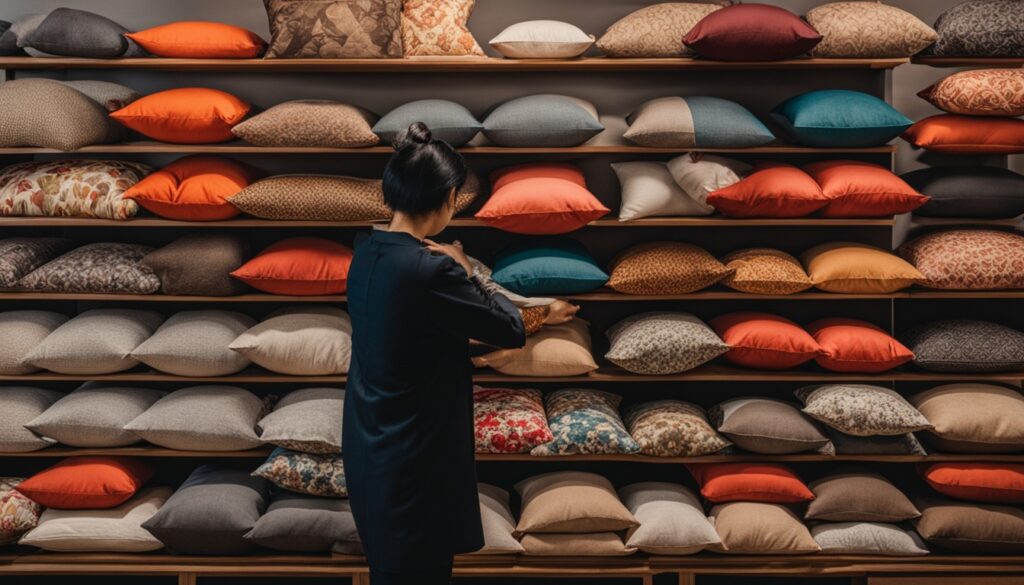Looking for the best sleep experience? A top Japanese pillow is key for unmatched comfort. These pillows, known for special designs and materials, cater to all sleep styles. They range from traditional buckwheat to modern ergonomic choices, each crafted with care.
Maruhati pillows are a hit in hotels across Japan, known for quality and comfort1. They use premium stuff like soft feathers and polyethylene pipes. This mix gives you support and softness, for better sleep1. Plus, they’re designed to keep your neck and spine aligned right, ensuring a pain-free sleep1.
In this guide, we’ll dive into various Japanese pillow types. We’ll help you pick one to drastically improve your sleep.
Key Takeaways
- Japanese pillows offer a range of styles for enhanced sleeping comfort.
- Maruhati pillows are recognized for their high-quality materials.
- Ergonomic designs promote better neck and spine alignment.
- Buckwheat pillows are durable and customizable based on personal preferences.
- These pillows also provide excellent temperature regulation during sleep.
Introduction to Japanese Pillows
Japanese pillows blend tradition and modern comfort. They use natural materials like buckwheat hulls, popular worldwide including the U.S2. People often pair a buckwheat pillow with a shikibuton on tatami mats. This setup allows breathability and moisture control for better sleep3.
The design of Japanese pillows is deeply rooted in culture. Since the 15th century, buckwheat pillows were a luxury for the rich. Now, they’re available for everyone2. This shift shows how these pillows have become widely accepted, meeting different sleep needs.
Traditional Japanese sleep systems offer many benefits. They help align the spine, keep sleepers cool, and are environmentally friendly. Families sleeping on large futons in tatami rooms strengthens bonds3. Knowing this helps us appreciate the design and cultural importance of Japanese pillows.
Understanding the Benefits of Japanese Pillows
Japanese pillows, especially those filled with buckwheat hulls, are becoming more popular. They provide great support which leads to better sleep. By fitting the head and neck closely, they offer support and comfort while avoiding sleep problems.
Support and Comfort
A buckwheat pillow’s firm support helps lessen neck and shoulder pain. It keeps the spine straight during sleep, fitting all sleeping positions4. These pillows don’t attract dust mites and are great for allergy sufferers5. They also keep you cool at night thanks to their airflow-promoting design6.
Adjustability for Different Sleep Positions
The adjustable japanese pillow can easily fit your needs. You can change its height in under five minutes4. This adaptability improves comfort for all kinds of sleepers. Unlike normal pillows, buckwheat pillows keep their shape and support for a long time6.
| Feature | Benefits |
|---|---|
| Support | Reduces neck and shoulder pain |
| Hypoallergenic | Resistant to dust mites; ideal for allergy sufferers |
| Temperature Regulation | Offers a cooling effect for better sleep |
| Durability | Can last up to ten years with proper care |
| Customizable | Adjusts to individual sleeping preferences in minutes |
What is a Buckwheat Pillow?
A buckwheat pillow is a sleep aid that’s becoming more popular. It’s known for its support and ability to adjust. These pillows are filled with buckwheat seeds’ hard outer hulls. This gives them a unique texture that helps with sleep. Learning about its history and how it’s made shows why it’s so liked.
Origin and History of Buckwheat Pillows
Buckwheat pillows started in Japan in the 15th century. They’re called sobakawa pillows7. Buckwheat was first brought to Japan around 300 BCE7. Today, they’re popular worldwide, especially in the U.S., for their cooling effect and health perks7.
Many adults suffer from back pain during sleep. That’s why chiropractors often suggest buckwheat pillows. They help relieve some of that discomfort7. You can also adjust the pillows’ height and firmness by adding or removing hulls. This makes them perfect for various sleeping styles7.
How Buckwheat Pillows are Made
The process of making these pillows is done by expert craftsmen. They use only high-quality, double cleaned, 100% organic buckwheat hulls from U.S. farms8. Each is then wrapped in a material like cotton or bamboo. This outer layer is breathable. A standard buckwheat pillow is 13″ x 18″ and weighs about 3.8 pounds8. This careful process means each pillow offers lasting comfort and support8.

Japanese Pillow Types: Traditional vs. Modern
Looking into Japanese pillows, we see a big difference between the old and new styles. Traditional ones like the sobakawa are small and firm. They fit well with Japan’s way of sleeping on the floor. This setup helps keep your back straight and reduces muscle pain9. The takamakura pillow is also special. It keeps your head up and saves the fancy hairstyles of geisha culture10.
Characteristics of Traditional Japanese Pillows
Old-school Japanese pillows usually have buckwheat inside. This makes them breathable and comfy for anyone. The height of these pillows ranges between three to seven inches. This lets people choose what suits their sleep best10. Also, there’s the shikifuton, a cozy cotton mattress. It works together with these pillows to make sleeping better9.
Modern Innovations in Pillow Design
Modern Japanese pillows, however, are all about new features. Things like adjustable filling and shapes that support your neck. The U-shaped pillows are really cool because they support your neck but still breathe like traditional ones. They come in sizes that are perfect for daily use, like the 12″x 18″ Japanese Size pillow11. Plus, silk pillowcases are in. They’re great for your hair and skin, making these pillows even more cutting-edge10.
Best Japanese Pillow Options for Sleep
Choosing the best Japanese pillow options offers standout choices for various sleep needs. The market features many buckwheat pillow options known for their unique fill and designs.
Top Recommendations for Buckwheat Pillows
The Pillowtex Kyoto Pillow mixes half buckwheat and half polyester. It promotes temperature regulation and supports different sleeping positions. It comes in Standard, Queen, and King sizes and is praised for its comfort. This pillow has a 100% cotton cover that suits stomach, side, and back sleepers12.
For a luxury choice, look at the PineTales Buckwheat Pillow. It uses top-grade Japanese buckwheat hulls and has an organic cotton cover. It’s lightweight and ensures cool, comfortable sleep13.
Other Popular Japanese Pillow Styles
The AiR 4D Pillow stands out with its adjustable layers for custom height preferences. Measuring 25 x 15 inches, it blends unique fillings for enhanced comfort and support14. This versatility shows the innovation in popular Japanese pillow styles. It aims for better sleep quality tailored to personal preferences.
Choosing the Right Japanese Pillow Design
When picking a Japanese pillow, a few key factors ensure you sleep comfortably. It’s essential to know these japanese pillow design factors to choose the best one for you. Think about how you sleep, what materials you like, and how thick you want the pillow.
Factors to Consider When Selecting a Pillow
Understanding your sleeping style is crucial for comfort. If you sleep on your back, a pillow with a medium thickness is best for neck alignment. Side sleepers might need a thicker pillow to support their shoulders. The traditional Japanese sleep system highlights the importance of a pillow that fits your needs. It should keep your neck and spine straight. Memory foam provides strong neck support, keeping your head steady. Down pillows, on the other hand, are softer and more comfortable for people who prefer plushness15.
Customization Options and Features
A great feature of customizable Japanese pillows is how you can adjust them for comfort. Many have sections that let you change the thickness and firmness. For example, buckwheat hull pillows can be adjusted for better support and cooler sleep because of airflow16. This is perfect for those who move a lot in their sleep or like different support levels. When choosing a japanese pillow, look for ones that you can tailor to your comfort for a good night’s sleep.

Japanese Pillow Care and Maintenance
Taking good care of your japanese pillow is crucial. This ensures your pillow remains comfortable and lasts longer. Specifically, those filled with buckwheat need a bit more attention. By understanding how to clean and maintain them, you can enjoy their support for a long time.
Cleaning Instructions for Buckwheat Pillows
When it’s time to clean your buckwheat pillow, begin by removing its cover. You can do this by unzipping the cover and taking out the buckwheat hulls. Make sure to wash the cotton cover in cold water on a gentle cycle. This prevents it from shrinking. Then, put the hulls in a pillowcase. This makes them easier to handle while cleaning.
If the hulls get dirty, they need to be dried quickly. This stops them from getting damaged17. It’s important to remember, you can’t wash whole buckwheat pillows in a machine. However, you can wash their covers if needed18.
Longevity Tips for Your Pillows
For better care of your buckwheat pillows, air them out in the sun. Do this once or twice a year for a few hours18. This lowers moisture and keeps them fresh. If the hulls feel damp, the sun can dry them out. But, if they’re very wet, you may need to replace them. They won’t recover well from being soaked18.
Using a pillowcase can greatly protect the buckwheat inside17. Over time, you might need new hulls. You can buy these in 10 and 20 lb. bags17.
Ergonomic Japanese Pillows: A Closer Look
Ergonomic Japanese pillows, crafted by Maruhati, match your spine and neck’s natural shape, offering more comfortable sleep. They use innovative materials and designs to help with sleep posture. This makes finding the right ergonomic pillow vital for a good night’s rest.
Benefits of Ergonomic Designs
Ergonomic pillows offer several benefits:
- They improve spine alignment, easing discomfort and allowing for deeper sleep.
- Their adjustable height suits personal sleep preferences.
- Their breathable materials lower allergy risks and boost cleanliness.
- These pillows are durable, retaining their shape and providing consistent support.
- They reflect Japanese craftsmanship, adding a touch of cultural heritage to comfort.
Studies show 98% of surveyed medical experts recommend ergonomic Japanese pillows19. They’re not just comfortable; they also reduce neck and shoulder pain. This aligns with traditional Japanese sleep methods20.
Choosing an Ergonomic Pillow for Your Needs
Here’s what to consider when choosing ergonomic pillows:
- Your sleeping position. Side, back, or stomach sleepers need different support.
- Pillow materials should keep you cool and dry for better sleep hygiene.
- Look for customization options to fit your preferences.
- Balance price and quality. High-quality pillows may offer more value over time.
With options like the Dr. Recommended Pillow series, featuring adjustable heights and comfortable materials, picking the right ergonomic Japanese pillow can greatly enhance your sleep quality19.
Where to Buy Japanese Pillows
Looking for a Japanese pillow? Knowing where to shop is key to finding an authentic and comfy choice. You can buy from online stores or visit specialty shops for a hands-on experience. Both options offer quality sleep enhancers.
Online Retailers and Specialty Stores
Online stores have a big selection of Japanese pillows. They have ones filled with buckwheat and other cool types. Plus, you might get free shipping if you spend over $99 and they often allow returns within 30 days21. Specialty shops can give you something unique. They have products from top brands like Maruhati, used in famous hotels22.
Things to Look For When Buying a Japanese Pillow
Choosing a pillow? Think about what it’s made of. Look for pillows that stay cool to keep you comfy at night. They come in sizes like standard, queen, and king to suit your bed21. Buying more than one could save you money with discounts on bulk purchases21. Make sure you pick a filling that suits your comfort level, like traditional buckwheat or modern materials22.



